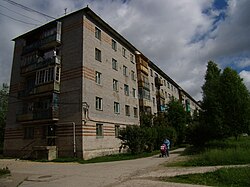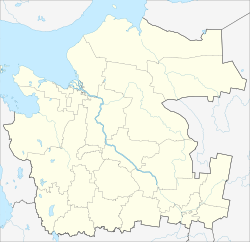Severoonezhsk (Russian: Северооне́жск) is an urban locality (an urban-type settlement) in Plesetsky District of Arkhangelsk Oblast, Russia, located 55 kilometers (34 mi) west of the town of Mirny, on the left bank of the Onega River. Municipally, it is the administrative center of Severoonezhskoye Urban Settlement, one of the eight urban settlements in the district. Population: 5,289 (2010 Census);[3] 5,624 (2002 Census);[7] 6,223 (1989 Soviet census).[8].
Severoonezhsk
Североонежск | |
|---|---|
 view of houses in the town | |
| Coordinates: 62°35′30″N 39°50′52″E / 62.59167°N 39.84778°E | |
| Country | Russia |
| Federal subject | Arkhangelsk Oblast |
| Administrative district | Plesetsky District[1] |
| Founded | 1973[2] |
| Population | |
| • Total | 5,289 |
| • Municipal district | Plesetsky Municipal District[4] |
| • Urban settlement | Severoonezhskoye Urban Settlement[4] |
| • Capital of | Severoonezhskoye Urban Settlement[4] |
| Time zone | UTC+3 (MSK |
| Postal code(s)[6] | 164268 |
| OKTMO ID | 11650188051 |
Geography
editSeveroonezhsk is located on the left bank of the Onega River, several kilometers downstream from the mouth of the Iksa River, the left tributary of the Onega. On the right bank of the Onega, across Severoonezhsk, stands the urban-type settlement of Oksovsky.
History
editThe first house in Severoonezhsk was built in February 1973 shortly after huge deposits of bauxite were discovered. Until 1985, Severoonezhsk was subordinate to the urban-type settlement of Oksovsky. On July 8, 1985, Severoonezhsk was granted urban-type settlement status itself, and was split from Oksovsky; with its territory including the whole area on the left bank of the Onega which had been part of Oksovsky.[2]
At the beginning of 1970, there were plans to build an aluminum production plant close to the bauxite deposits. It was planned that the plant would be served by a city with the population of approximately 100,000, with the name of Severorossiysk, located on both banks of the Onega. The plans were supported by Hungary and Bulgaria, who were interested in becoming the shareholders. The plans have never been realized.[9]
Economy
editIndustry
editBauxite extraction is the main industry in Severoonezhsk. The bauxites were discovered in the area in 1949, and the extraction (the North Onezhsky mine) began in 1978.[10]
Transportation
editOksovsky (Navoloki railway station) is at the end of the railway line which connects in Puksa to the line between Moscow and Arkhangelsk (Konosha-Obozyorskaya stretch). There is a railway bridge from Severoonezhsk (Iksa railway station) to Oksovsky across the Onega, connecting to the railway to the west of Severoonezhsk, to Undozero and Yangory. This line (Zaonezhskaya Railroad) is one of the biggest railways in Russia which does not belong to Russian Railways. The owner of the railway is the State Department of Corrections. Plans to extend this line to Medvezhyegorsk have not been realized.
There is a road connecting Severoonezhsk to Oksovsky and further on to the highway which is a historic trading route between Kargopol with Arkhangelsk.
The Onega is not navigable at Severoonezhsk because of the rapids.
Culture and recreation
editThe weekly newspaper of Plesetsky District, Kuryer Prionezhya (Russian: Курьер Прионежья), has been published since 1999. The editorial office is in Severoonezhsk.[11]
References
editNotes
edit- ^ a b Государственный комитет Российской Федерации по статистике. Комитет Российской Федерации по стандартизации, метрологии и сертификации. №ОК 019-95 1 января 1997 г. «Общероссийский классификатор объектов административно-территориального деления. Код 11 250 588 003», в ред. изменения №278/2015 от 1 января 2016 г.. (State Statistics Committee of the Russian Federation. Committee of the Russian Federation on Standardization, Metrology, and Certification. #OK 019-95 January 1, 1997 Russian Classification of Objects of Administrative Division (OKATO). Code 11 250 588 003, as amended by the Amendment #278/2015 of January 1, 2016. ).
- ^ a b МО "Оксовское" (in Russian). МО "Плесецкий район". Retrieved August 5, 2011.
- ^ a b Russian Federal State Statistics Service (2011). Всероссийская перепись населения 2010 года. Том 1 [2010 All-Russian Population Census, vol. 1]. Всероссийская перепись населения 2010 года [2010 All-Russia Population Census] (in Russian). Federal State Statistics Service.
- ^ a b c Архангельское областное Собрание депутатов. Областной закон №258-внеоч.-ОЗ от 23 сентября 2004 г. «О статусе и границах территорий муниципальных образований в Архангельской области», в ред. Областного закона №224-13-ОЗ от 16 декабря 2014 г. «Об упразднении отдельных населённых пунктов Соловецкого района Архангельской области и о внесении изменения в статью 46 Областного закона "О статусе и границах территорий муниципальных образований в Архангельской области"». Вступил в силу со дня официального опубликования. Опубликован: "Волна", №38, 8 октября 2004 г. (Arkhangelsk Oblast Council of Deputies. Oblast Law #258-vneoch.-OZ of September 23, 2004 On the Status and Borders of the Territories of the Municipal Formations in Arkhangelsk Oblast, as amended by the Oblast Law #224-13-OZ of December 16, 2014 On Abolishing Several Inhabited Localities in Solovetsky District of Arkhangelsk Oblast and on Amending Article 46 of the Oblast Law "On the Status and Borders of the Territories of the Municipal Formations in Arkhangelsk Oblast". Effective as of the day of the official publication.).
- ^ "Об исчислении времени". Официальный интернет-портал правовой информации (in Russian). June 3, 2011. Retrieved January 19, 2019.
- ^ Почта России. Информационно-вычислительный центр ОАСУ РПО. (Russian Post). Поиск объектов почтовой связи (Postal Objects Search) (in Russian)
- ^ Federal State Statistics Service (May 21, 2004). Численность населения России, субъектов Российской Федерации в составе федеральных округов, районов, городских поселений, сельских населённых пунктов – районных центров и сельских населённых пунктов с населением 3 тысячи и более человек [Population of Russia, Its Federal Districts, Federal Subjects, Districts, Urban Localities, Rural Localities—Administrative Centers, and Rural Localities with Population of Over 3,000] (XLS). Всероссийская перепись населения 2002 года [All-Russia Population Census of 2002] (in Russian).
- ^ Всесоюзная перепись населения 1989 г. Численность наличного населения союзных и автономных республик, автономных областей и округов, краёв, областей, районов, городских поселений и сёл-райцентров [All Union Population Census of 1989: Present Population of Union and Autonomous Republics, Autonomous Oblasts and Okrugs, Krais, Oblasts, Districts, Urban Settlements, and Villages Serving as District Administrative Centers]. Всесоюзная перепись населения 1989 года [All-Union Population Census of 1989] (in Russian). Институт демографии Национального исследовательского университета: Высшая школа экономики [Institute of Demography at the National Research University: Higher School of Economics]. 1989 – via Demoscope Weekly.
- ^ Лукашов, Виталий (July 7, 2004). "Проект "Северороссийск"". Независимый взгляд (18). Arkhangelsk. Retrieved August 6, 2011.
- ^ ОАО "Северо-Онежский бокситовый рудник" (in Russian). МО "Плесецкий район". 2010. Retrieved July 2, 2011.
- ^ Курьер Прионежья (in Russian). Retrieved July 19, 2011.
Sources
edit- Архангельское областное Собрание депутатов. Областной закон №65-5-ОЗ от 23 сентября 2009 г. «Об административно-территориальном устройстве Архангельской области», в ред. Областного закона №232-13-ОЗ от 16 декабря 2014 г. «О внесении изменений в отдельные Областные Законы в сфере осуществления местного самоуправления и взаимодействия с некоммерческими организациями». Вступил в силу через десять дней со дня официального опубликования. Опубликован: "Волна", №43, 6 октября 2009 г. (Arkhangelsk Oblast Council of Deputies. Oblast Law #65-5-OZ of September 23, 2009 On the Administrative-Territorial Structure of Arkhangelsk Oblast, as amended by the Oblast Law #232-13-OZ of December 16, 2014 On Amending Various Oblast Laws Dealing with the Process of Municipal Self-Government and Relations with Non-Profit Organizations. Effective as of the day which is ten days after the official publication.).


